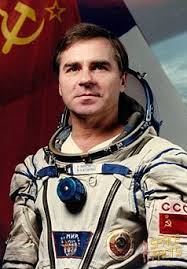Aleksandr Viktorenko
Russian - (RFSA)
Deceased
Date of Birth: March 29, 1947
Date of Death: Aug. 10, 2023
Aleksandr Stepanovich Viktorenko (Александр Степанович Викторенко) was a Soviet cosmonaut. He was born in Olginka, North-Kazakhstan Oblast, Kazakh SSR on March 29, 1947. He is married with two children. He was selected as a cosmonaut on March 23, 1978, and retired on May 30, 1997. During his active career he had been Commander of Soyuz TM-3, Soyuz TM-8, Soyuz TM-14 and Soyuz TM-20. He has spent a total of 489 days in space.
Soyuz-U2 | Soyuz TM-2
Soviet Space Program | RussiaBaikonur Cosmodrome, Republic of Kazakhstan
Feb. 5, 1987, 9:38 p.m.
Status: Success
Mission:
Soyuz TM-2 was the first crewed flight of the new Soyuz TM spacecraft and the second long-duration mission to Mir space station. The mission began on February 5, 1987, 21:38:16 UTC, launching Commander Yuri Romanenko and Flight Engineer Aleksandr Laveykin into orbit. They docked with Mir two days later. During their stay there, new module was docked to the station. Crew was visited by several Progress resupply missions and by a crewed Soyuz TM-3 mission. The mission concluded with a safe landing back on Earth on December 29, 1987, 09:16:00 UTC.
Low Earth OrbitSoyuz-U2 | Soyuz TM-3
Soviet Space Program | RussiaBaikonur Cosmodrome, Republic of Kazakhstan
July 22, 1987, 1:59 a.m.
Status: Success
Mission:
Soyuz TM-3 was the third mission to Mir space station. The mission began on July 22, 1987, 01:59:17 UTC, launching Commander Alexander Viktorenko, Flight Engineer Aleksandr Aleksandrov and Research Cosmonaut Muhammed Faris, the first Syrian cosmonaut, into orbit. They docked with Mir two days later. During their stay there, crew conducted Earth observation, medical and other scientific experiments. The mission concluded with a safe landing back on Earth on July 30, 1987, 01:04:12 UTC.
Low Earth OrbitSoyuz-U2 | Soyuz TM-8
Soviet Space Program | RussiaBaikonur Cosmodrome, Republic of Kazakhstan
Sept. 5, 1989, 9:38 p.m.
Status: Success
Mission:
Soyuz TM-8 was the eighth mission and the fifth long-duration expedition to Mir space station. The mission began on September 5, 1989, 21:38:03 UTC, launching Commander Alexander Viktorenko and Flight Engineer Aleksandr Serebrov into orbit. They docked with Mir two days later. During their stay there, cosmonauts performed five EVAs, various station maintenance tasks, and carried out scientific experiments in medicine, geophysics, space technology, earth observation, astronomy etc. The crew returned after 166 days in orbit, landing safely back on Earth on February 19, 1990, 04:36:18 UTC.
Low Earth OrbitSoyuz-U2 | Soyuz TM-14
Soviet Space Program | RussiaBaikonur Cosmodrome, Republic of Kazakhstan
March 17, 1992, 10:54 a.m.
Status: Success
Mission:
Soyuz TM-14 was the 14th mission and the 11th long-duration expedition to Mir space station. It was the first mission after the USSR collapsed, and so became the first Russian space flight. The mission began on March 17, 1992, 10:54:30 UTC, launching Commander Alexander Viktorenko, Flight Engineer Alexander Kaleri and Research Cosmonaut Klaus-Dietrich Flade into orbit. They docked with Mir two days later. During their stay there, cosmonauts performed an EVA, various station repair and maintenance tasks, and carried out scientific experiments in materials research, space technology, astrophysics and earth observation. They were visited by several Progress resupply spacecrafts, and welcomed aboard the Soyuz TM-15 crew. The mission concluded with a safe landing back on Earth on August 10, 1992, 01:05:02 UTC.
Low Earth OrbitSoyuz-U2 | Soyuz TM-20
Soviet Space Program | RussiaBaikonur Cosmodrome, Republic of Kazakhstan
Oct. 3, 1994, 10:42 p.m.
Status: Success
Mission:
Soyuz TM-20 was the 20th mission and the 17th long-duration expedition to Mir space station. The mission began on October 3, 1994, 22:42:30 UTC, launching Commander Alexander Viktorenko, Flight Engineer Yelena Kondakova and Research Cosmonaut Ulf Merbold into orbit. They docked with Mir two days later. During their stay there, cosmonauts performed two EVAs, carried out various scientific experiments. Station crew was visited by several Progress resupply spacecrafts, and welcomed aboard the Soyuz TM-21 crew. During this mission the first rendezvous maneuver of the Space Shuttle STS-63 with the Mir space station was performed. The mission concluded with a safe landing back on Earth on March 22, 1995, 04:04:05 UTC.
Low Earth OrbitThe Roscosmos State Corporation for Space Activities, commonly known as Roscosmos, is the governmental body responsible for the space science program of the Russian Federation and general aerospace research. Soyuz has many launch locations the Russian sites are Baikonur, Plesetsk and Vostochny however Ariane also purchases the vehicle and launches it from French Guiana.
New Shepard
NS-33
West Texas Suborbital Launch Site/ Corn Ranch - Corn Ranch, Van Horn, TX, USANS-33 is the 13th crewed flight for the New Shepard program and the 33rd in its history.
Falcon 9
Starlink Group 15-7
Space Launch Complex 4E - Vandenberg SFB, CA, USAA batch of 26 satellites for the Starlink mega-constellation - SpaceX's project for space-based Internet communication system.
H-IIA
GOSAT-GW (Ibuki GW)
Yoshinobu Launch Complex LP-1 - Tanegashima Space Center, JapanGOSAT-GW (Greenhouse Gases Observing Satellite Greenhouse gases and Water cycle), also known as Ibuki GW and formerly known as GOSAT 3, is JAXA's nex…
Electron
Symphony In The Stars
Rocket Lab Launch Complex 1B - Rocket Lab Launch Complex 1, Mahia Peninsula, New Zealand'Symphony In The Stars' is the first of two dedicated missions on Electron to deploy a single spacecraft to a 650km circular Earth orbit for a confid…
Falcon 9
Starlink Group 10-34
Space Launch Complex 40 - Cape Canaveral SFS, FL, USAA batch of 27 satellites for the Starlink mega-constellation - SpaceX's project for space-based Internet communication system.



